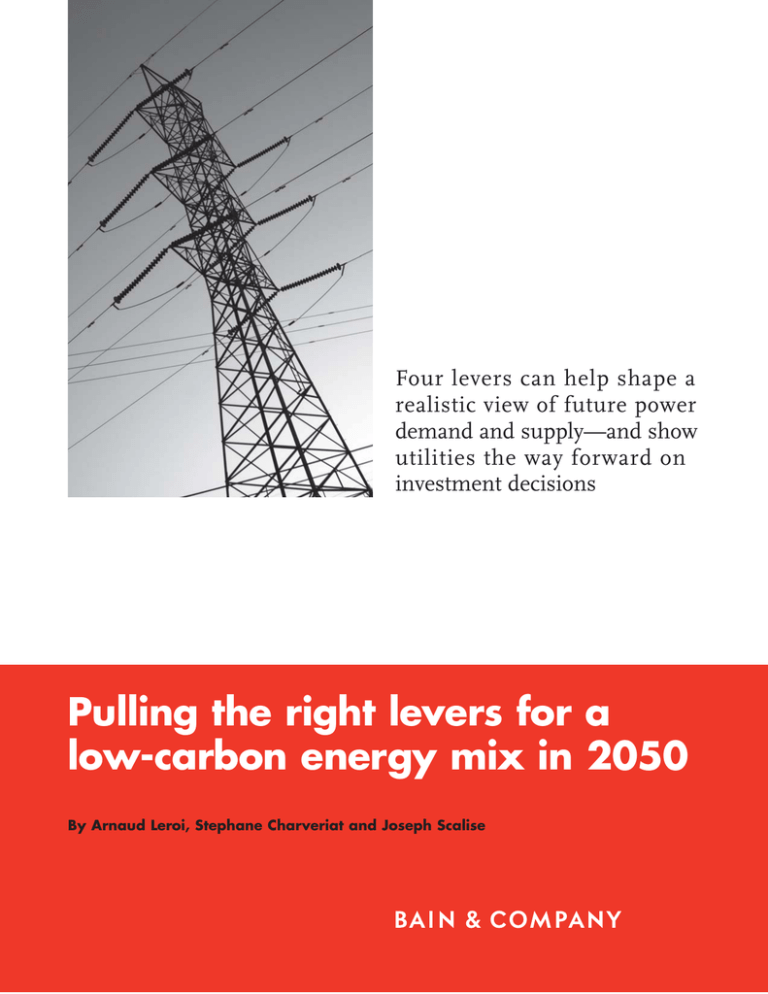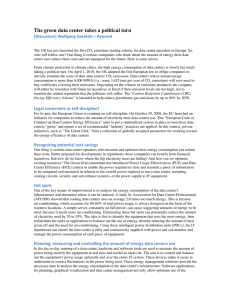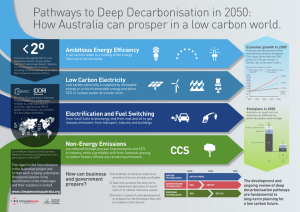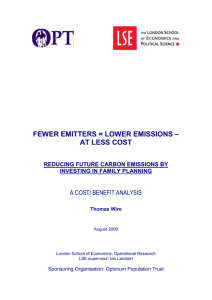
Four levers can help shape a
realistic view of future power
demand and supply—and show
utilities the way forward on
investment decisions
Pulling the right levers for a
low-carbon energy mix in 2050
By Arnaud Leroi, Stephane Charveriat and Joseph Scalise
Arnaud Leroi and Stephane Charveriat are partners with Bain & Company and
work in the Utilities practice in Paris. Joseph Scalise is a Bain partner in San
Francisco and leads the US Utilities practice.
Copyright © 2010 Bain & Company, Inc. All rights reserved.
Content: Manjari Raman, Elaine Cummings
Layout: Global Design
Pulling the right levers for a low-carbon energy mix in 2050
Four levers can help
shape a realistic view of
future power demand
and supply—and show
utilities the way forward
on investment decisions
Four decades is a long time—except when the
goal is to reduce carbon emissions by 80 percent. Over the next 10 years, utilities around
the world will make significant investments
to renew their generating capacity and meet
the growing demand for power. These decisions
will require tough choices due to several reasons: the pressure on the balance sheets of
most utilities, the financial constraints of governments that will limit the potential for subsidies and the evolving regulatory environment
that will mandate reduced CO2 targets. Bain &
Company research shows that if governments
use four levers to build a vision for the future
supply and demand of power, they will not just
help utilities make better investment choices in
the short term—but also improve the country’s
competitiveness and emerge as flag bearers in
the march toward a low CO2 era.
Identifying the right criteria
Given the scale of the issue, these investment
decisions require a robust and realistic view
of a low CO2 competitive energy mix by 2050.
With global population increasing by almost
two billion in the next 20 years, energy demand
will balloon by 1.5 percent every year. For most
planners, managing and controlling demand
represents a top priority—best pursued through
energy efficiency goals (see Figure 1). Bain &
Company research shows that in Europe, a
Figure 1: Energy efficiency is the best lever to reduce CO2 emissions, but will not
be sufficient
Electricity demand in Europe
C02 emissions in Europe
CAGR
(10–50)
EU27 electricity demand (TWh)
5.000
0.9%
2050 CO2 emissions (Gt)
1.5
0.7%
4.000
1.3
0.4%
1.0
1.0
3.000
0.7
2.000
0.5
1.000
0
2010
2020
2030
2040
2050
IEA reference scenario
10% electricity efficiency increase in 2050
20% electricity efficiency increase in 2050
0.0
Reference
scenario
Percent of C02
emissions decrease:
10%
electricity
efficiency
increase
20%
electricity
efficiency
increase
18%
48%
Source: IEAWEO 2009; Bain model
1
Pulling the right levers for a low-carbon energy mix in 2050
10 percent reduction in power consumption by
2050 will reduce CO2 emissions by 18 percent
and a 20 percent reduction in power consumption will reduce emissions by 48 percent. Yet
measures to curb energy consumption can
only go so far. In parallel, countries also need
to develop a game plan to identify the right
energy mix such that they minimize their
carbon footprint as well as meet the growing
hunger for energy.
The power sector offers the most scope for
reducing CO2 emissions. In 2007, power generation accounted for 41 percent of the world’s
CO2 emissions, well ahead of transportation
(26 percent) and all other sectors combined
(33 percent). For most developed countries,
achieving an 80 percent reduction in CO 2
emissions by 2050 means “decarbonizing” the
power sector by 90 percent—which clearly
presents a major challenge. As other sectors
like transportation try to reduce their carbon
footprints—for example, through the use of
electric cars—they will generate even greater
demand for power.
Yet the sooner countries shift their power generation to less carbon-intensive capacities, the
better their odds of getting to the right competitive mix by 2050. Power generation represents 43 percent of all CO2 emissions in the
United States and 37 percent in Europe. By
identifying the right mix of power technologies
that make their economies more competitive,
the US and Europe can reduce emissions by
80 percent by 2050—if they make the right
choices now.
When we analyzed the installed capacity in the
US in 2008, we found that the existing capacities still operating in 2050 will account for only
about 5 percent of the demand at that time.
2
The US will need to invest in new assets or
renew existing ones to meet 95 percent of the
demand in 2050 (see Figure 2). In the case of
Europe, Bain estimates the EU-27 will need to
invest to meet nearly 90 percent of the total
demand in 2050. The scope might appear
daunting at first, but currently available technologies offer plenty of options to invest in
power infrastructure that can help meet demand
at low CO2 levels by 2050. The power cost will
clearly be higher—roughly €30 per ton of CO2
avoided in Europe and $20 per ton in the US—
but affordable as long as the target for reducing
CO 2 emissions remains below 90 percent
(see Figure 3). Eliminating the remaining 10
percent emissions will imply financial burdens
that could jeopardize the competitiveness of
the economy. Most governments and key decision makers can therefore start the process of
meeting the 90 percent reduction right away.
Their challenge: identifying the right affordable
power mix for 2050.
In our experience, when defining an energy
policy, most governments make trade-offs
between as many as five criteria.
1.
Cost of the electricity
2.
Amount of CO2 emissions
3.
Security of supply
4.
Ability to capture the value created by
power assets locally
5.
Public acceptance of the available technology
With no optimal mix, each country or region
must define its own “potentially appropriate”
combination based on the relative importance
of each criterion for that country or region.
Pulling the right levers for a low-carbon energy mix in 2050
Figure 2: Many options exist to build a low CO2 competitive mix as most of the assets
needed in 2050 are yet to be developed
Europe
US
EU27 electricity production (TWh)
US electricity production (TWh)
Other renewables 6%
3,395
100%
Other renewables 3%
Oil 1%
3,977
4,915
100%
Hydro 9%
New
capacities
and
capacities
to be
renewed
~58%
80
Nuclear
29%
60
Oil 3%
80
New
capacities
and
capacities
to be
renewed
~89%
Gas
21%
40
20
60
20
2030
2008
~5,300
Nuclear
18%
Gas
22%
New
capacities
and
capacities
to be
renewed
~75%
40
Coal
31%
0
~4,350
0
2050
~6,700
Hydro 7%
New
capacities
and
capacities
to be
renewed
~95%
Coal
49%
2008
2030
2050
Note: “Other renewables” includes wind, biomass, solar and geothermal
Source: IEAWEO 2009; Bain model
Figure 3: Opportunities exist to reduce CO2 emissions by 90 percent—but the cost increases
with rising levels of ambition
Europe
US
2050 cost per ton of CO2 avoided (real 2008 €/t CO2)
2050 cost per ton of CO2 avoided (real 2008 $/t CO2)
60
60
50
50
40
40
30
30
20
20
10
10
0.5 0.45 0.4 0.35 0.3 0.25 0.2 0.15 0.1
0.7 0.65 0.6 0.55 0.5 0.45 0.4 0.35 0.3 0.25 0.2 0.15
EU27 2050 electricity CO2 emissions (Gt)
US 2050 electricity CO2 emissions (Gt)
CO2 emissions
reduction vs.
1990 (%): 66
70
73
77
80
83
87
90
93
71 73 75 77 80 82 84 86 88 90 92 94
Source: Bain model
3
Pulling the right levers for a low-carbon energy mix in 2050
Despite the growing pressure to reduce carbon
emissions, for many countries criteria such as
security and public acceptance gained greater
importance in the last decade. In many US
states and in some European countries, citizen
groups campaign to block new nuclear plants.
Today, nuclear energy provides only 18 percent
of US energy needs—equivalent to 0.32 kilowatt (KW) per inhabitant. In contrast, in France,
nuclear energy provides almost 75 percent of
all electricity generated (equivalent to 1 KW
per inhabitant), but wind energy struggles to
gain wide acceptance. To be eligible for tariffs,
wind farms can be built only in restricted Wind
Power Development Zones. Meanwhile, in
Germany, which is often at the cutting edge of
experimenting with new low CO2 technologies,
the pilot test for carbon capture and sequestering (CCS) faced public opposition. Vattenfall’s
Schwarze Pumpe project in Spremberg, Northern Germany, which was meant to be a global
demonstration for the three key stages of trapping, transporting and burying greenhouse
gases, was forced to release CO2 directly into
the atmosphere when Germans protested “not
under my backyard.”
Four levers to shift to lower
CO 2 emissions
When we applied the framework of the five
issues to the US and the EU-27, the Bain model
for optimizing the energy mix showed that
countries can choose between many different
paths to get to a low-emissions competitive
mix by 2050. We found that the energy mix
decisions became simpler if countries focus
on four main levers:
“Decarbonization” of the base load: The demand
for base load power generation accounts for
85 percent of current CO 2 emissions from
4
power generation in Europe and up to 92 percent in the US (see Figure 4). Decarbonizing
the base load production of electricity attacks
the problem at scale, but raises the next challenge of finding the right technology.
Currently, there are at least seven low CO2
technologies. Five of these are already operational: run of river hydraulic; geothermal;
biomass; nuclear; and alternative energy sources
like wind and solar. Two technologies are still
maturing: concentrating solar power (CSP)
with storage, and coal and gas with carbon
capture and storage (CCS). Each source of
power comes with its own constraints. Rivers,
geothermal and biomass technologies will
quickly reach the limits of available natural
resources; technologies like CSP with storage
and coal or gas with CCS are still to develop
commercially to full potential.
Given the existing installed capacity and technology constraints, the US and the EU-27 can
take several paths to a low CO2 future by 2050,
depending on the trade-offs they make. For
example, countries can depend on low-cost
renewable sources such as run of river, biomass
and geothermal for their competitiveness and
low CO2 emissions, but these natural resources
have finite potential. Or, countries can bet on
CCS, which shows promise as a low CO2 technology, but still needs to evolve as a viable
financial model for business. Another option:
Countries can use nuclear power to reduce the
cost of electricity as well as CO2 emissions, but
nuclear technology comes with a considerable
time lag.
Options such as nuclear power and CCS become
even more complex due to the time and cost
involved in these projects. Bain estimates show
that if Europe and the US completely ignore
Pulling the right levers for a low-carbon energy mix in 2050
Figure 4: Base load decarbonization is the top priority as the base load generates 85 percent
of the electricity-led CO2 in Europe and 92 percent in the US
Europe
US
EU27 2008 electricity CO2 emissions by load level (Gt)
US 2008 electricity CO2 emissions by load level (Gt)
Peak 1%
Semibase low 2%
Peak 1%
100%
1.2
Semibase low 6%
100%
2.2
Semibase high 5%
Semibase high 8%
80
80
60
60
40
Base 85%
Base 92%
40
20
20
0
0
Source: IEAWEO 2009; Bain analysis
nuclear power in the mix, it would increase
electricity costs by 30 percent in Europe and
28 percent in the US compared with a balanced
mix that includes nuclear supply (see Figure 5).
However, given the issues around licensing,
feasibility and construction, a nuclear project can
mean a lead time of almost 10 years. Similarly,
not including CCS development in the mix
could increase electricity costs by 13 percent in
Europe and 26 percent in the US compared
with a balanced mix. However, the jury is
still out on how long CCS technology will take
to mature.
Shifting high CO2-emitting power capacities to
serve semi-base and peak load demand: When
renewing semi-base and peak load capacities
and reinvesting in new low CO2 infrastructure,
countries can switch supply. They can use existing high CO2 emission base load power plants,
fired by coal or gas, to service demand only at
less frequent load levels. Displacing high CO2emitting plants to meet less frequent demand
has several benefits.
Our model shows that under certain conditions,
displacement could reduce the EU-27’s cumulative carbon emissions by 15 percent over the
next 40 years. In the US, an additional benefit is a potential drop in the cost of electricity:
Redeploying older assets to meet demand at
less frequent load levels and investing in cleaner
base load production technologies could reduce
the price of electricity from $69 per megawatthour (MWh) to $66 per MWh. However, to get
the best from displacement, utilities will have to
speed up substantial investments. For example,
the US would need to invest $1,533 billion by
2020 versus $1,332 billion without displacement.
Relying on wind and solar in the near term: Even
with displacement, most of the power a country
5
Pulling the right levers for a low-carbon energy mix in 2050
Figure 5: To decarbonize electricity at a competitive cost, the energy mix requires technologies
such as nuclear and carbon capture and storage (CCS)
Europe
US
US average cost of electricity of
new installed capacities (real 2008 $/M Wh)
EU27 average cost of electricity of
new installed capacities (real 2008 €/M Wh)
+30%
80
+28%
78
+13%
100
+26%
68
60
84
85
No CCS
capacities
in the mix
No nuclear
capacities
in the mix
80
60
66
60
40
40
20
0
20
Balanced mix
Nuclear = 19%
CCS = 24%
No CCS
capacities
in the mix
No nuclear
capacities
in the mix
0
Balanced mix
Nuclear = 17%
CCS = 33%
Source: Bain model
needs will still come from high carbon-emitting
plants. In the US and in Europe, wind and solar
power can play a critical role in immediately
reducing dependence on high CO2-emitting
power-generation technologies. Most countries
will need a short-term plan based on these
technologies to dovetail into the long-term goal
of reducing carbon emissions by 2050.
However, renewable energy sources have limitations, too. They can be volatile, as they depend
on intermittent sources of energy: the wind
and sun. Many countries worry that wind and
solar energy are still not dependable enough
to cover base load demand. Another deterrent:
The cost of electricity storage seems likely to
remain prohibitive for quite some time.
Wind and solar also represent a high initial
capital investment, with marginal operating
costs once the infrastructure is up and running.
6
If too widely deployed, they will reduce the
ability to get the full benefit from low CO 2
competitive base load infrastructure based on
nuclear energy or coal with CCS. The Bain
model estimates that in Europe, a competitive
power mix where 240 gigawatts (GW) of power
is generated by wind and solar capacities by
2050 will require €1,408 billion in total investments over the period. Depending further on
wind- and solar-generated power—say to meet
600 GW demand—will require additional investments of roughly €250 billion and increase the
total cost of electricity by nearly 10 percent.
Managing demand: An effective way for a country to reach its 2050 goal is by tackling the
demand profile for power. By looking for innovative ways to transfer semi-base and peak
demand to base load—which is cheaper to
decarbonize—a country can dramatically reduce
carbon emissions at a lower cost. In one pro-
Pulling the right levers for a low-carbon energy mix in 2050
jection, the EU 27 can reduce the required
power capacity from 773 GW to 670 GW by
shifting 13 percent of peak demand to a more
average level of demand.
However, managing demand comes with its
own issues. A critical constraint in balancing
energy demand across regions—and for that
matter, across different sources of energy—is
the state of the transmission and distribution
networks. Such networks become even more
complex when they cross national boundaries.
It took almost 20 years, for example, to build
the interconnection capacities between France
and Spain.
Moreover, the aggressive push to reduce CO2
emissions comes at a cost: To renew and develop
these capacities, utilities in the US would need
to invest 30 percent more and in Europe 25
percent more than “business as usual” between
now and 2050. But the payoff would be higher,
too. In Europe, for example, countries can
choose the right low CO2 technology for themselves by prioritizing options that stimulate
economic growth and create more jobs locally
(see Figure 6).
The road ahead
As countries choose their optimal energy mix,
they must consider two factors that can stall—
or accelerate—activity. The first is the role of
capital. Most options for a competitive low
CO2 mix in 2050 require higher capital investments today for lower operating costs tomorrow.
That puts tremendous pressure on utilities to
come up with the requisite cash in the short
term. The private sector can play a crucial role
in bridging the need for capital, but that raises
the second issue: a stable, predictable environment for energy investments. The more the
Figure 6: By choosing the right low CO2 technologies, countries can ensure that a higher
share of the value created by power generation investments stays local
Europe
US
Localization of the average cost of
electricity of new EU27capacities (%)
100%
8
Localization of the average cost of electricity
of new base load capacities in the US (%)
100%
8
80
8
13
80
43
43
53
60
88
100
100
100
92
60
92
100
100
100
92
40
40
87
57
57
47
20
0
Local Local
CSP; run coal
of river; with
dam; CCS
geothermal
20
12
Local Nuclear Wind
gas
with
CCS
PV Imported Imported
coal
gas
with
with
CCS
CCS
Share of value not captured locally
0
CSP,
run of
river, dam,
geothermal
Local
coal
with
CCS
Local
gas
with
CCS
Wind Nuclear
PV
Share of value captured locally
Source: Bain model
7
Pulling the right levers for a low-carbon energy mix in 2050
profit pool in energy depends on unclear and
changing rules and regulations made by governments, the less likelihood of private capital
shifting to the energy sector.
Bold approaches require strong leadership and
therefore, getting to the right energy mix by
2050 will test both the public and the private
sectors. Government can play a key role in
launching initiatives that steer the mix in the
right direction, providing access to financing
and creating an environment of stability and
transparency that attracts investments. Private
leadership will feature in an equally significant role. Investors will need to assess and
allocate risks. Technology developers will need
to speed up the rollout and development of
new low CO2 technologies.
Meanwhile, power generation companies will
need to ramp up plans to renew old assets or
build new low-carbon facilities. They can also
play a role in educating both the public and
private sectors on stimulating R&D and pushing
for the development of common and competitive
standards on these technologies: Smooth license
processes and collaboration on standards could
substantially reduce the cost of investments.
Most of all, despite the flux in the regulatory
environment, utilities can choose to embark
swiftly on their journey to 2050, by taking the
first steps needed to develop a clear vision of
the future.
Key contacts in Bain & Company’s Global Utilities practice are:
Europe:
Stephane Charveriat in Paris (stephane.charveriat@bain.com)
Julian Critchlow in London (julian.critchlow@bain.com)
Frederic Debruyne in Brussels (frederic.debruyne@bain.com)
Berthold Hannes in Düsseldorf (berthold.hannes@bain.com)
Arnaud Leroi in Paris (arnaud.leroi@bain.com)
Roberto Prioreschi in Rome (roberto.prioreschi@bain.com)
Nacho Rios Calvo in Madrid (nacho.rios@bain.com)
Philip Skold in Stockholm (philip.skold@bain.com)
Kalervo Turtola in Helsinki (kalervo.turtola@bain.com)
Americas:
Neil Cherry in San Francisco (neil.cherry@bain.com)
Stuart Levy in Atlanta (stuart.levy@bain.com)
Alfredo Pinto in São Paulo (alfredo.pinto@bain.com)
Joseph Scalise in San Francisco (joseph.scalise@bain.com)
Asia:
Sharad Apte in Southeast Asia (sharad.apte@bain.com)
Amit Sinha in New Delhi (amit.sinha@bain.com)
For additional information, please visit www.bain.com
8
Pulling the right levers for a low-carbon energy mix in 2050
Bain’s business is helping make companies more valuable.
Founded in 1973 on the principle that consultants must measure their success in terms
of their clients’ financial results, Bain works with top management teams to beat competitors
and generate substantial, lasting financial impact. Our clients have historically outperformed
the stock market by 4:1.
Who we work with
Our clients are typically bold, ambitious business leaders. They have the talent, the will
and the open-mindedness required to succeed. They are not satisfied with the status quo.
What we do
We help companies find where to make their money, make more of it faster and sustain
its growth longer. We help management make the big decisions: on strategy, operations,
technology, mergers and acquisitions and organization. Where appropriate, we work with
them to make it happen.
How we do it
We realize that helping an organization change requires more than just a recommendation.
So we try to put ourselves in our clients’ shoes and focus on practical actions.
For more information, please visit www.bain.com







